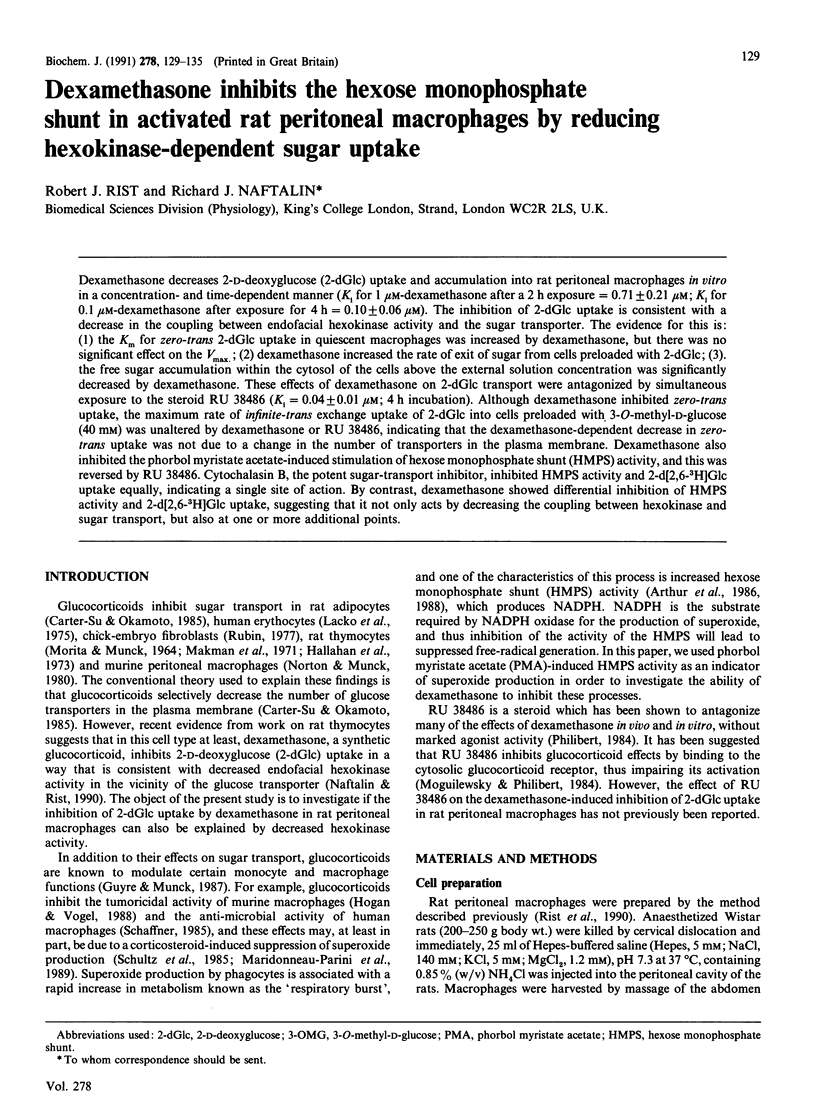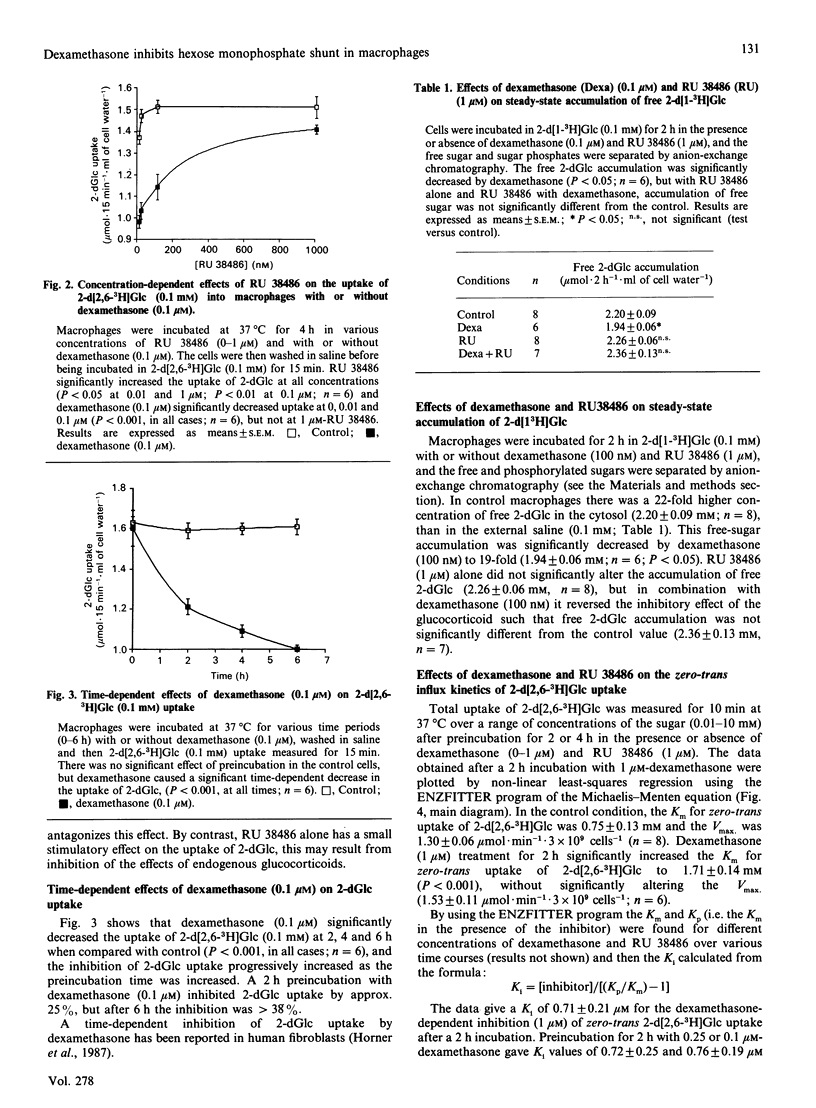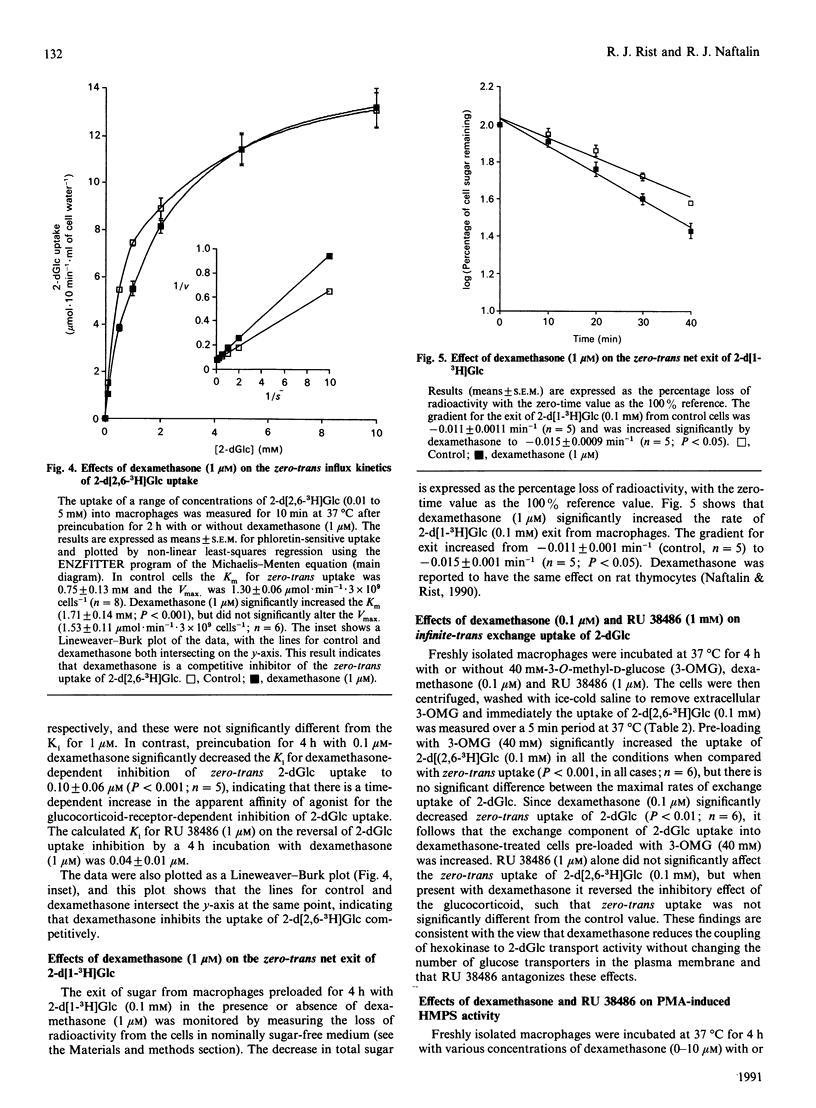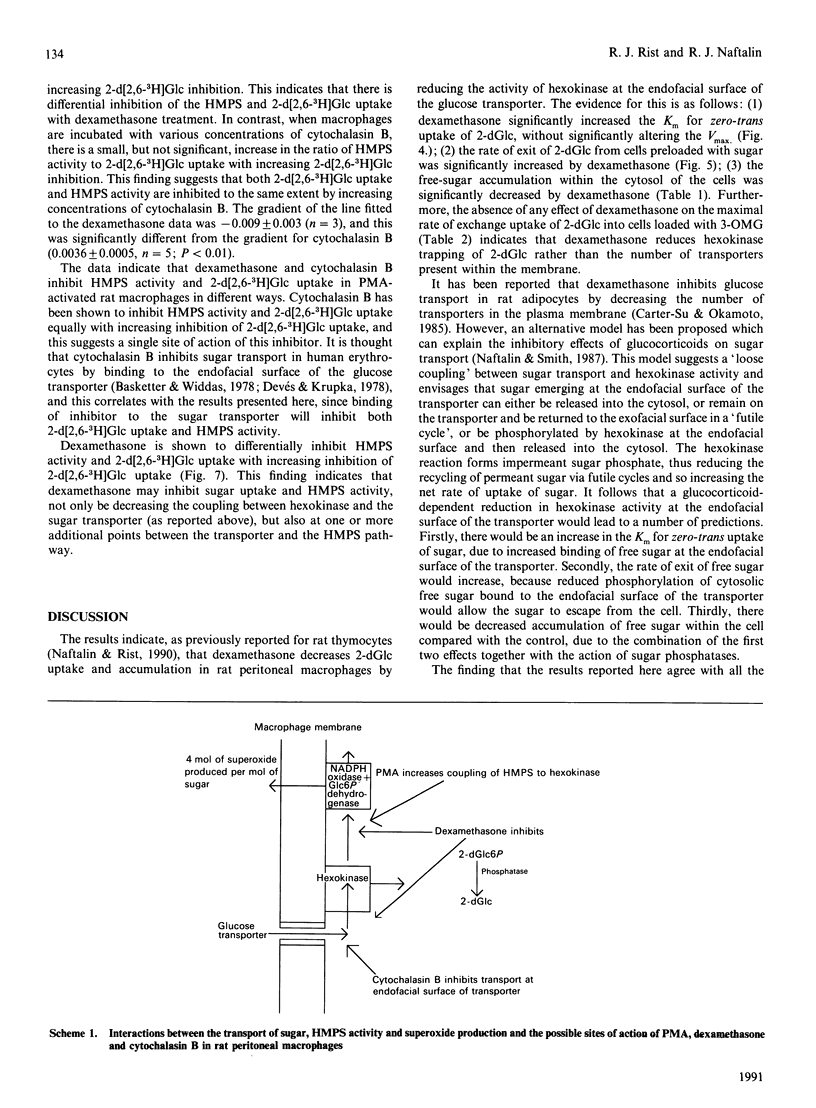Abstract
Dexamethasone decreases 2-D-deoxyglucose (2-dGlc) uptake and accumulation into rat peritoneal macrophages in vitro in a concentration- and time-dependent manner (Ki for 1 microM-dexamethasone after a 2 h exposure = 0.71 +/- 0.21 microM; Ki for 0.1 microM-dexamethasone after exposure for 4 h = 0.10 +/- 0.06 microM). The inhibition of 2-dGlc uptake is consistent with a decrease in the coupling between endofacial hexokinase activity and the sugar transporter. The evidence for this is: (1) the Km for zero-trans 2-dGlc uptake in quiescent macrophages was increased by dexamethasone, but there was no significant effect on the Vmax.; (2) dexamethasone increased the rate of exit of sugar from cells preloaded with 2-dGlc; (3). the free sugar accumulation within the cytosol of the cells above the external solution concentration was significantly decreased by dexamethasone. These effects of dexamethasone on 2-dGlc transport were antagonized by simultaneous exposure to the steroid RU 38486 (Ki = 0.04 +/- 0.01 microM; 4 h incubation). Although dexamethasone inhibited zero-trans uptake, the maximum rate of infinite-trans exchange uptake of 2-dGlc into cells preloaded with 3-O-methyl-D-glucose (40 mM) was unaltered by dexamethasone or RU 38486, indicating that the dexamethasone-dependent decrease in zero-trans uptake was not due to a change in the number of transporters in the plasma membrane. Dexamethasone also inhibited the phorbol myristate acetate-induced stimulation of hexose monophosphate shunt (HMPS) activity, and this was reversed by RU 38486. Cytochalasin B, the potent sugar-transport inhibitor, inhibited HMPS activity and 2-d[2,6-3H]Glc uptake equally, indicating a single site of action. By contrast, dexamethasone showed differential inhibition of HMPS activity and 2-d[2,6-3H]Glc uptake, suggesting that it not only acts by decreasing the coupling between hexokinase and sugar transport, but also at one or more additional points.
Full text
PDF






Selected References
These references are in PubMed. This may not be the complete list of references from this article.
- Alnemri E. S., Litwack G. Glucocorticoid-induced lymphocytolysis is not mediated by an induced endonuclease. J Biol Chem. 1989 Mar 5;264(7):4104–4111. [PubMed] [Google Scholar]
- Arthur M. J., Kowalski-Saunders P., Wright R. Corynebacterium parvum-elicited hepatic macrophages demonstrate enhanced respiratory burst activity compared with resident Kupffer cells in the rat. Gastroenterology. 1986 Jul;91(1):174–181. doi: 10.1016/0016-5085(86)90455-5. [DOI] [PubMed] [Google Scholar]
- Arthur M. J., Kowalski-Saunders P., Wright R. Effect of endotoxin on release of reactive oxygen intermediates by rat hepatic macrophages. Gastroenterology. 1988 Dec;95(6):1588–1594. doi: 10.1016/s0016-5085(88)80082-9. [DOI] [PubMed] [Google Scholar]
- Basketter D. A., Widdas W. F. Asymmetry of the hexose transfer system in human erythrocytes. Comparison of the effects of cytochalasin B, phloretin and maltose as competitive inhibitors. J Physiol. 1978 May;278:389–401. doi: 10.1113/jphysiol.1978.sp012311. [DOI] [PMC free article] [PubMed] [Google Scholar]
- Carter-Su C., Okamoto K. Effect of glucocorticoids on hexose transport in rat adipocytes. Evidence for decreased transporters in the plasma membrane. J Biol Chem. 1985 Sep 15;260(20):11091–11098. [PubMed] [Google Scholar]
- Compton M. M., Cidlowski J. A. Identification of a glucocorticoid-induced nuclease in thymocytes. A potential "lysis gene" product. J Biol Chem. 1987 Jun 15;262(17):8288–8292. [PubMed] [Google Scholar]
- Devés R., Krupka R. M. Cytochalasin B and the kinetics of inhibition of biological transport: a case of asymmetric binding to the glucose carrier. Biochim Biophys Acta. 1978 Jul 4;510(2):339–348. doi: 10.1016/0005-2736(78)90034-2. [DOI] [PubMed] [Google Scholar]
- Hallahan C., Young D. A., Munck A. Time course of early events in the action of glucocorticoids on rat thymus cells in vitro. Synthesis and turnover of a hypothetical cortisol-induced protein inhibition of glucose metabolism and of a presumed ribonucleic acid. J Biol Chem. 1973 Apr 25;248(8):2922–2927. [PubMed] [Google Scholar]
- Hogan M. M., Vogel S. N. Inhibition of macrophage tumoricidal activity by glucocorticoids. J Immunol. 1988 Jan 15;140(2):513–519. [PubMed] [Google Scholar]
- Horner H. C., Munck A., Lienhard G. E. Dexamethasone causes translocation of glucose transporters from the plasma membrane to an intracellular site in human fibroblasts. J Biol Chem. 1987 Dec 25;262(36):17696–17702. [PubMed] [Google Scholar]
- Lacko L., Wittke B., Geck P. Interaction of steroids with the transport system of glucose in human erythrocytes. J Cell Physiol. 1975 Dec;86 (Suppl 2)(3 Pt 2):673–680. doi: 10.1002/jcp.1040860512. [DOI] [PubMed] [Google Scholar]
- MORITA Y., MUNCK A. EFFECT OF GLUCOCORTICOIDS IN VIVO AND IN VITRO ON NET GLUCOSE UPTAKE AND AMINO ACID INCORPORATION BY RAT-THYMUS CELLS. Biochim Biophys Acta. 1964 Oct 9;93:150–157. doi: 10.1016/0304-4165(64)90269-7. [DOI] [PubMed] [Google Scholar]
- Makman M. H., Dvorkin B., White A. Evidence for induction by cortisol in vitro of a protein inhibitor of transport and phosphorylation processes in rat thymocytes. Proc Natl Acad Sci U S A. 1971 Jun;68(6):1269–1273. doi: 10.1073/pnas.68.6.1269. [DOI] [PMC free article] [PubMed] [Google Scholar]
- Maridonneau-Parini I., Errasfa M., Russo-Marie F. Inhibition of O2- generation by dexamethasone is mimicked by lipocortin I in alveolar macrophages. J Clin Invest. 1989 Jun;83(6):1936–1940. doi: 10.1172/JCI114101. [DOI] [PMC free article] [PubMed] [Google Scholar]
- Moguilewsky M., Philibert D. RU 38486: potent antiglucocorticoid activity correlated with strong binding to the cytosolic glucocorticoid receptor followed by an impaired activation. J Steroid Biochem. 1984 Jan;20(1):271–276. doi: 10.1016/0022-4731(84)90216-4. [DOI] [PubMed] [Google Scholar]
- Naftalin R. J., Rist R. J. Effects of phorbol, dexamethasone and starvation on 3-O-methyl-D-glucose transport by rat thymocytes. Modulation of transport by altered trans effects. Biochem J. 1990 Jan 1;265(1):251–259. doi: 10.1042/bj2650251. [DOI] [PMC free article] [PubMed] [Google Scholar]
- Naftalin R. J., Rist R. J. Evidence that activation of 2-deoxy-D-glucose transport in rat thymocyte suspensions results from enhanced coupling between transport and hexokinase activity. Biochem J. 1989 May 15;260(1):143–152. doi: 10.1042/bj2600143. [DOI] [PMC free article] [PubMed] [Google Scholar]
- Naftalin R. J., Smith P. M. A model for accelerated uptake and accumulation of sugars arising from phosphorylation at the inner surface of the cell membrane. Biochim Biophys Acta. 1987 Feb 12;897(1):93–111. doi: 10.1016/0005-2736(87)90318-x. [DOI] [PubMed] [Google Scholar]
- Newsholme P., Curi R., Gordon S., Newsholme E. A. Metabolism of glucose, glutamine, long-chain fatty acids and ketone bodies by murine macrophages. Biochem J. 1986 Oct 1;239(1):121–125. doi: 10.1042/bj2390121. [DOI] [PMC free article] [PubMed] [Google Scholar]
- Newsholme P., Gordon S., Newsholme E. A. Rates of utilization and fates of glucose, glutamine, pyruvate, fatty acids and ketone bodies by mouse macrophages. Biochem J. 1987 Mar 15;242(3):631–636. doi: 10.1042/bj2420631. [DOI] [PMC free article] [PubMed] [Google Scholar]
- Norton J. M., Munck A. In vitro actions of glucocorticoids on murine macrophages: effects on glucose transport and metabolism, growth in culture, and protein synthesis. J Immunol. 1980 Jul;125(1):259–266. [PubMed] [Google Scholar]
- Rist R. J., Jones G. E., Naftalin R. J. Synergistic activation of 2-deoxy-D-glucose uptake in rat and murine peritoneal macrophages by human macrophage colony-stimulating factor-stimulated coupling between transport and hexokinase activity and phorbol-dependent stimulation of pentose phosphate-shunt activity. Biochem J. 1990 Jan 1;265(1):243–249. doi: 10.1042/bj2650243. [DOI] [PMC free article] [PubMed] [Google Scholar]
- Rubin H. Antagonistic effects of insulin and cortisol on coordinate control of metabolism and growth in cultured fibroblasts. J Cell Physiol. 1977 May;91(2):249–259. doi: 10.1002/jcp.1040910210. [DOI] [PubMed] [Google Scholar]
- Schaffner A. Therapeutic concentrations of glucocorticoids suppress the antimicrobial activity of human macrophages without impairing their responsiveness to gamma interferon. J Clin Invest. 1985 Nov;76(5):1755–1764. doi: 10.1172/JCI112166. [DOI] [PMC free article] [PubMed] [Google Scholar]
- Schultz R. M., Nanda S. K., Altom M. G. Effects of various inhibitors of arachidonic acid oxygenation on macrophage superoxide release and tumoricidal activity. J Immunol. 1985 Sep;135(3):2040–2044. [PubMed] [Google Scholar]


